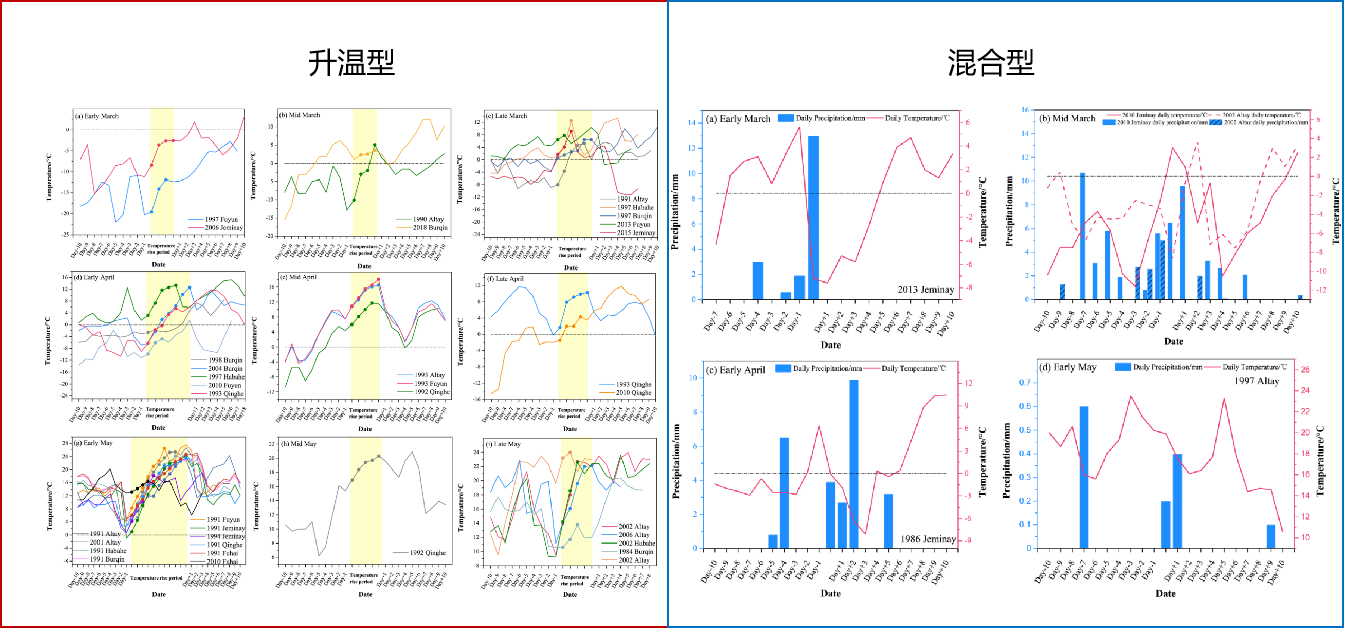
Research Highlight

Flood disasters rank among the most frequent and destructive natural hazards globally. Under the influence of global climate change, the frequency, intensity, and impacts of spring snowmelt flood disasters have undergone significant alterations. The Altay region in Xinjiang is a high-incidence area for spring snowmelt floods, where such events exert extensive impacts on ecosystems, regional economic development, agro-pastoral production, and residents' livelihoods. Based on disaster data from spring snowmelt flood events in Altay (1984–2018), this study analyzes: 1) Spatio-temporal distribution characteristics of disaster-causing snowmelt floods. 2) Atmospheric circulation and thermodynamic conditions driving warming-type snowmelt floods. The findings provide critical references for flood prevention strategies in this region.

Fig. The evolution of daily average temperature and precipitation before and after the occurrence of temperature-rise type and mixed type snowmelt flood events in Altay region during spring seasons from 1984 to 2018.
The Central Asian Climate Research Team of the Desert Research Institute classified the disaster-causing snowmelt floods by using 49 disaster-causing snowmelt flood events in the Altay region in spring, based on the occurrence date of the disaster-causing snowmelt floods and the changes in previous temperature and precipitation. They can be divided into temperature-rise type and mixed type disaster-causing snowmelt floods, among which the temperature-rise type accounts for 81.6%. The spatial distribution of different types of disaster-causing snowmelt floods in each month is different. In March, disaster-causing snowmelt floods mostly occur in the southwest of Altay, mainly of the mixed type; in April, disaster-causing snowmelt floods are concentrated in the southeast, mainly of the temperature-rise type; in May, temperature-rise type snowmelt floods occur in various cities (counties) of the Altay region. Since the frequency of temperature-rise type disaster-causing snowmelt floods in spring in the Altay region is relatively high, typical cases of extreme temperature-rise type disaster-causing snowmelt floods in each month of spring were selected to analyze the key factors such as atmospheric circulation and thermal conditions. It is found that during the extreme temperature-rise type snowmelt flood processes in different months, the Altay region is controlled by a high-pressure ridge in the 500 hPa geopotential height field, and it is manifested as a geopotential height positive anomaly. For example, when the temperature-rise snowmelt flood occurred in May 1991, the 500 hPa geopotential height field showed that the Ural Mountain high-pressure ridge moved eastward, and the Altay region was controlled by a positive geopotential height anomaly. At the same time, the Altay region is controlled by an abnormal southeasterly wind in the 850 hPa height field. In terms of thermal conditions, the energy balance in different months has different influences on the surface temperature in spring. In March and April, the temperature rise is mainly dominated by net long-wave radiation, which dominates the change of surface net heat flux and is conducive to temperature rise; in May, the strong subsidence movement reduces the total cloud cover, allowing more net short-wave radiation flux to reach the surface, leading to an abnormal rise in temperature. This study systematically classifies the spring disaster-causing snowmelt floods in the Altay region and conducts a comprehensive analysis combined with atmospheric circulation and thermal conditions. The research results help to deepen the understanding of the formation mechanism of spring snowmelt floods and have guiding significance for flood warning and disaster prevention and control in the Altay region. In the future, the research team will further combine multi-source snowmelt flood data to deeply explore the formation mechanisms of various snowmelt floods and provide more powerful support for meteorological early warning and disaster prevention and mitigation.
The relevant achievements were published in Journal of Hydrology: Regional Studies under the title "Spring Snowmelt Flood Disasters in Altay, Northwest China: Spatio-temporal Distribution and Mechanisms". The first author of the paper is Research Assistant Dilinuer from the Institute of Desert Research, and the corresponding author is Researcher Mao Weiyi from the Institute of Desert Research. The research was supported by the Xinjiang Natural Science Foundation (2022D01A121, 2023D01A16), the Key Research and Development Special Project of Xinjiang Uygur Autonomous Region (2022B03021-1), and the Innovation and Development Special Project of Xinjiang Meteorological Bureau (MS202403).
Original information: Dilinuer T., Mao W.Y., Yao J.Q., et al., 2025. Spring Snowmelt Flood Disasters in Altay, Northwest China: Spatio-temporal Distribution and Mechanisms. Journal of Hydrology: Regional Studies, 57, 102142.
Article link: https://doi.org/10.1016/j.ejrh.2024.102142

0991-2652429

desert@idm.cn

新疆维吾尔自治区乌鲁木齐市建国路327号


Scan to follow
us on WeChat